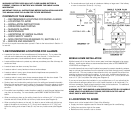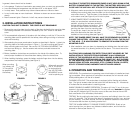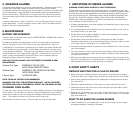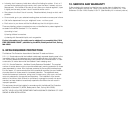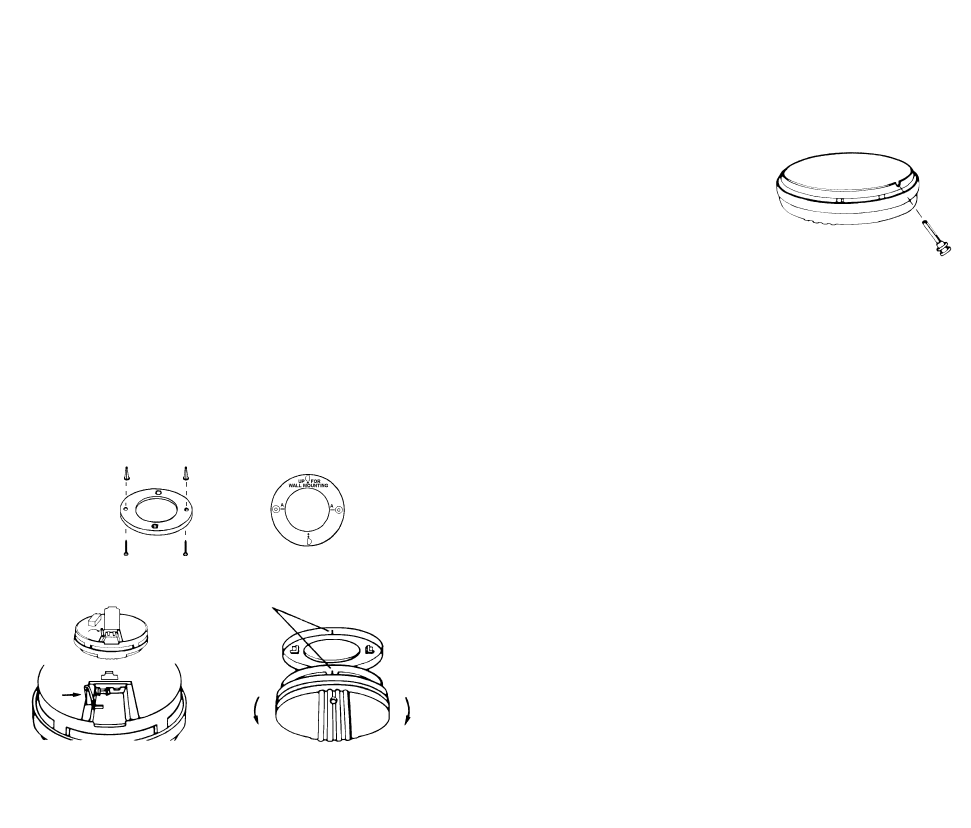
In general, alarms should not be located:
•In the garage. Products of combustion are present when you start your automobile.
•In an area where the temperature may fall below 40ºF or rise above 100ºF.
•In dusty areas. Dust particles may cause nuisance alarms or failure to alarm.
•In very humid areas or near a bathroom. Moisture or steam can cause nuisance
alarms.
• Near fluorescent lights. Electronic “noise” may cause nuisance alarms.
3.INSTALLATION INSTRUCTIONS
CAUTION: THIS UNIT IS SEALED. THE COVER IS NOT REMOVABLE!
1. Remove the mounting plate from the back of the alarm by holding the mounting plate
and twisting the alarm in the direction indicated by the “OFF” arrow on the alarm
cover.
2. To insure aesthetic alignment of the alarm with the hallway or wall, the “A” line on the
mounting plate must be parallel with the hallway when ceiling mounting or horizontal
when wall mounting.
3. After selecting the proper smoke alarm location as described in Section 1, attach the
mounting plate to the ceiling as shown in Figure 1. For wall mounting see Figure 2.
Place mounting plate on the wall. Be sure the “UP FOR WALL MOUNTING “ text
and arrow are facing up. Use the screws and anchors provided to secure the
mounting plate.
4. Battery installation instructions are provided on the inside of the battery door. To
ensure proper installation of the smoke alarm battery, follow the instructions.
5. When installing the battery, press the battery reminder finger down into the battery
compartment and install the battery (see Figure 3).
FIGURE 1
FIGURE 2
FIGURE 3 FIGURE 4
When mounting
in a hallway, the
“A” line should
be parallel with
the hallway.
When wall mounting,
the “A” line should
be horizontal and
the “UP FOR WALL
MOUNTING” arrow
must be pointing up.
Alignment Marks
Install
Remove
CAUTION! IF THE BATTERY REMINDER FINGER IS NOT HELD DOWN IN THE
BATTERY COMPARTMENT BY THE BATTERY, THE BATTERY DOOR WILL NOT
CLOSE AND THE UNIT WILL NOT ATTACH TO THE MOUNTING BRACKET.
6. Alignment marks are provided on the edge of the trim plate and the alarm. After
installing the mounting plate, place the alarm on the mounting plate with the align-
ment marks lined up. Twist the alarm in the direction indicated by the “ON” arrow
on the alarm cover (see Figure 4) until it locks in place.
7. USING TAMPER RESIST LOCKING PIN: To
make your smoke alarm somewhat tamper
resistant, a locking pin has been provided in
the bag with the screws and anchors. Using
this pin will deter children and others from
removing the alarm from the mounting plate.
To use the pin, insert it into the hole in the
side of the alarm after the alarm has been
installed on the mounting plate (see Figure 5).
NOTE: THE TAMPER RESIST PIN WILL HAVE TO BE REMOVED IN ORDER TO
CHANGE THE BATTERY. USE A LONG NOSE PLIERS TO PULL THE PIN OUT
OF THE HOLE. IT IS NOW POSSIBLE TO REMOVE THE ALARM FROM THE
MOUNTING PLATE.
8. After installation, test your alarm by depressing and holding down the test button
for several seconds, or by blowing smoke into the alarm. This should sound the
alarm.
CAUTION! EARLY WARNING FIRE DETECTION IS BEST ACHIEVED BY THE
INSTALLATION OF FIRE DETECTION EQUIPMENT IN ALL ROOMS AND
AREAS OF THE HOUSEHOLD AS FOLLOWS: A SMOKE ALARM INSTALLED
IN EACH SEPARATE SLEEPING AREA (IN THE VICINITY OF - BUT OUTSIDE
OF THE BEDROOM) AND HEAT OR SMOKE ALARMS IN THE LIVING ROOM,
DINING ROOM, KITCHEN, HALLWAYS, ATTIC, FURNACE ROOM, CLOSETS,
UTILITY STORAGE ROOM, BASEMENT AND ATTACHED GARAGE.
4.OPERATION AND TESTING
OPERATION: The smoke alarm is operating once a fresh battery is installed and test-
ing is complete. When products of combustion are sensed, the unit sounds a loud
85db pulsating alarm until the air is cleared.
FLASHING LED LIGHT: This smoke alarm is equipped with a flashing red indicator
light. The light is located under the test button and will flash every 30 - 40 seconds
to indicate that the smoke alarm is receiving power
SMOKE SENSINGCHAMBER OPERATION: This alarm will “chirp” if any of the com-
ponents in the smoke sensing chamber fail. This chirp will occur between the flashes
of the red LED indicator light. (If the chirp occurs at the same time as the red LED
flash, see Section 6 for low battery information.)
TESTING: Test by pushing the test button on the cover and holding it down for a min-
imum of 5 seconds. This will sound the alarm if the electronic circuitry, horn, and bat-
tery are working. If no alarm sounds, the unit has defective batteries or other failure.
You can also test the alarm by blowing smoke into it.
TEST THE ALARM WEEKLY TO ENSURE PROPER OPERATION. Erratic or low
sound coming from your alarm may indicate a defective alarm, and it should be
returned for service (see Section 11).
Tamper Resist
Locking Pin
FIGURE 5




